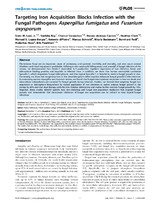Targeting Iron Acquisition Blocks Infection with the Fungal Pathogens Aspergillus fumigatus and Fusarium oxysporum
Autor
Leal Jr., Sixto M.
Roy, Sanhita
Vareechon, Chairut
Jesús Carrión, Steven de
Clark, Heather
Sánchez López-Berges, M.
Di Pietro, Antonio
Schrettl, Marcus
Beckmann, Nicola
Redl, Bernhard
Haas, Hubertus
Pearlman, Eric
Editor
Public Library of ScienceFecha
2013Materia
CorneaFungal diseases
Aspergillus fumigatus
Fungal growth
Neutrophils
Statins
Eye diseases
Eyes
METS:
Mostrar el registro METSPREMIS:
Mostrar el registro PREMISMetadatos
Mostrar el registro completo del ítemResumen
Filamentous fungi are an important cause of pulmonary and systemic morbidity and mortality, and also cause corneal
blindness and visual impairment worldwide. Utilizing in vitro neutrophil killing assays and a model of fungal infection of the
cornea, we demonstrated that Dectin-1 dependent IL-6 production regulates expression of iron chelators, heme and
siderophore binding proteins and hepcidin in infected mice. In addition, we show that human neutrophils synthesize
lipocalin-1, which sequesters fungal siderophores, and that topical lipocalin-1 or lactoferrin restricts fungal growth in vivo.
Conversely, we show that exogenous iron or the xenosiderophore deferroxamine enhances fungal growth in infected mice.
By examining mutant Aspergillus and Fusarium strains, we found that fungal transcriptional responses to low iron levels and
extracellular siderophores are essential for fungal growth during infection. Further, we showed that targeting fungal iron
acquisition or siderophore biosynthesis by topical application of iron chelators or statins reduces fungal growth in the
cornea by 60% and that dual therapy with the iron chelator deferiprone and statins further restricts fungal growth by 75%.
Together, these studies identify specific host iron-chelating and fungal iron-acquisition mediators that regulate fungal
growth, and demonstrate that therapeutic inhibition of fungal iron acquisition can be utilized to treat topical fungal
infections.

